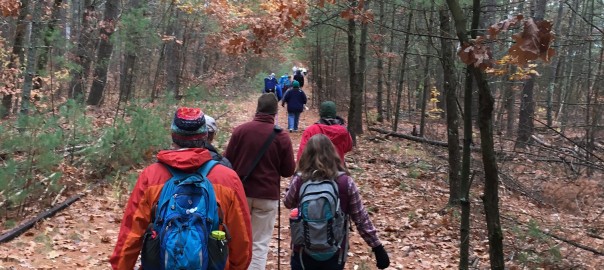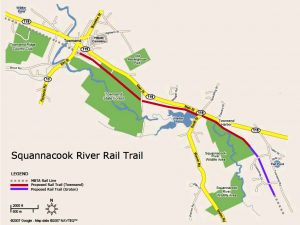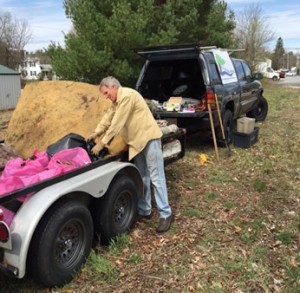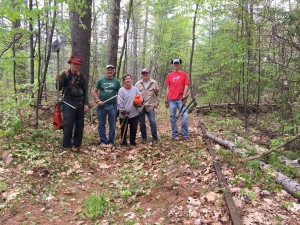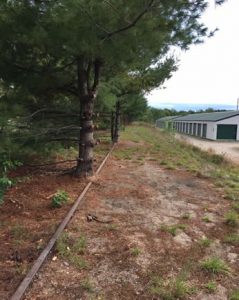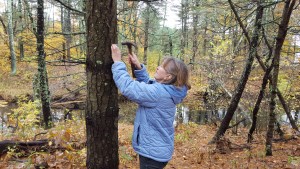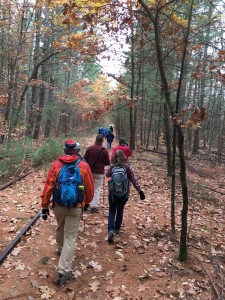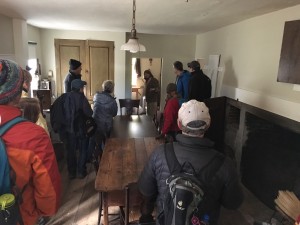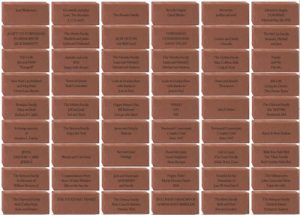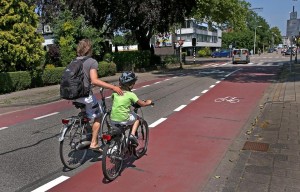The year 2016 was a eventful one for the Squannacook River Rail Trail. After twelve years of effort, Squannacook Greenways signed the MBTA lease for the unused rail bed in Townsend and Groton in 2015. With this lease, our non-profit won the right to construct a rail trail, and the public won legal access to this rail bed for the first time since the Peterborough and Shirley Railroad was constructed in the late 1840’s.
With legal access to the rail bed, our first priority was to finally let the public walk the rail bed for themselves. We felt that when people saw for themselves how the rail trail will make it so much easier to walk or bicycle around our area, they would understand the enthusiasm we felt for this project. They would see why we feel that this rail trail will transform what its like to grow up and live around here.
In April 2016, Squannacook Greenways held its first annual Earth Day rail trail clean up. Over 25 volunteers showed up and removed 75 bags of trash from the rail bed. Our thanks to the Town of Townsend for sponsoring this event town-wide.
To make the trail easily walkable from one end to another, one final section near Harbor Pond needed to be cleared.
Squannacook Greenways won approval for this work from the Townsend Conservation Commission, and in May 2016, a group of board members and a few volunteers worked to clear the last section of the rail bed without a walking path next to it.
This was not the only clearing that occurred in 2016. Benjamin Chidester of Townsend organized a group of scouts to help clear a section of the Squannacook River Rail Trail near Depot Street in Townsend, as his Eagle Scout project. Our sincere thanks to Benjamin and all the scouts who helped make the Squannacook River Rail Trail walkable from one end to another.
On a very rainy Saturday in October of 2016, a number of volunteers helped Squannacook Greenways put up
green arrow trail markers along the Squannacook River Rail Trail. Our hope is that these markers will encourage everyone to come out and walk the trail, and so see for yourselves that the stone dust trail will provide residents wanting to bike or walk from one part of town to another a safe alternative to the busy and dangerous Route 119.
On Nov 5, 2016, Squannacook Greenways, in conjuction with Freedom’s Way National Heritage Area and the Townsend Historical Society, held a
guided one way walk of the Squannacook River Rail Trail. We were thrilled when over 60 people turned up to enjoy the walk. Thanks to everyone who attended, and thanks to the Townsend Historical Society for offering walkers a tour of the Reed Homestead.
Not only was 2016 an exciting year for the Squannacook River Rail Trail because of the public events, it was also a year that moved as much closer financially to being able to build the trail. In June of 2016, Squannacook Greenways was pleased to announce that they had been awarded a $10,000 grant from the Bruce J. Anderson Foundation. This grant will go directly toward the construction of the stone dust Squannacook River Rail Trail.
Informed by intelligence, sensitivity, and the knowledge of many countries and cultures, Bruce J. Anderson was a serious and idealistic young man who cared deeply about the problems he saw around him. The Bruce J. Anderson Foundation was established in 1980 by Bruce’s brothers and sisters to honor Bruce and support the causes he championed. Squannacook Greenways, with its goal of making life better and more active for all residents, but especially younger ones, is proud to have been chosen to receive this grant.
Around the same time, Squannacook Greenways kicked off its buy a brick
fundraiser, which ran until Dec. 31st. In the end, this fundraiser raised more than $18,000, and more than 150 bricks were sold. In addition, the McNabb and Reeves families donated at the granite bench level ($5000) and a number of other individuals donated at the granite pillar level ($1000). In all, our capital campaign went from $43,000 at the beginning of 2016 to $87,000 at present. Thanks to all our donors for helping to bring the start of construction closer with each donation!
Finally, Squannacook Greenways has made good progress in the permitting process in 2016. Members of the board have meet with Dave Paulson, of The Natural Heritage & Endangered Species Program (NHESP), part of the Massachusetts Division of Fisheries and Wildlife. One outcome was that NHESP encouraged construction outside of the season when turtles are most active, which means that later fall and early winter would be the optimal construction period.
Thanks to all our supporters for making 2016 such a great year for us, and keep on eye out on our facebook page, mailing list, and web site for upcoming 2017 activities. We are especially excited about a family activity day on the trail, with all sorts of kids activities planned along the way. See you all on the rail trail!
